Real-Time FPGA-Based Balance Control Method for a Humanoid Robot Pushed by External Forces
Abstract
1. Introduction
2. Small-Sized Humanoid Robot
3. FPGA-Based Balance Control Method
3.1. External Force Detection
3.2. Push Recovery Balance Control
| Algorithm 1 Pseudo code of the proposed push recovery balance control. |
| Method: Push Recovery Balance Control. |
| Initialize the safety thresholds and |
| ← Update from a gyroscope and an accelerometer |
| if ( > ) or ( < −) then |
| else |
| end |
3.3. Trajectory Planning
3.4. Inverse Kinematics
4. Experimental Results
4.1. Balance Control with Stepping Forward
4.2. Balance Control with Stepping Backward
5. Conclusions
Author Contributions
Funding
Conflicts of Interest
References
- Li, T.H.S.; Su, Y.T.; Liu, S.H.; Hu, J.J.; Chen, C.C. Dynamic balance control for biped robot walking using sensor fusion, Kalman filter, and fuzzy logic. IEEE Trans. Ind. Electron. 2012, 59, 4394–4408. [Google Scholar] [CrossRef]
- Wong, C.C.; Liu, C.C. FPGA realisation of inverse kinematics for biped robot based on CORDIC. Electron. Lett. 2013, 49, 332–334. [Google Scholar] [CrossRef]
- Lai, W.Z.; Huang, H.P.; Chen, J.H. Real-time control of a humanoid robot. In Proceedings of the International Conference on Advanced Robotics and Intelligent Systems, Taipei, Taiwan, 6–8 September 2017; pp. 17–23. [Google Scholar]
- Vukobratovi’c, V.; Borovac, B. Zero-moment point-thirty five years of its life. Int. J. Humanoid Robot. 2004, 1, 157–173. [Google Scholar] [CrossRef]
- Chang, Y.H.; Oh, Y.; Kim, D.; Hong, S. Balance control in whole body coordination framework for biped humanoid robot MAHRU-R. In Proceedings of the IEEE International Symposium on Robot and Human Interactive Communication, Munich, Germany, 1–3 August 2008; pp. 401–406. [Google Scholar]
- Tu, K.Y.; Liu, M.S. Planning of sagittal gait of biped robots based on minimum motion energy. Int. J. Hum. Robot. 2010, 7, 635–667. [Google Scholar] [CrossRef]
- Hu, Y.; Mombaur, K. Bio-inspired optimal control framework to generate walking motions for the humanoid robot iCub using whole body models. Appl. Sci. 2018, 8, 278. [Google Scholar] [CrossRef]
- Kajita, S.; Morisawa, M.; Miura, K.; Nakaoka, S.; Harada, K.; Kaneko, K.; Kanehiro, F.; Yokoi, K. Biped walking stabilization based on linear inverted pendulum tracking. In Proceedings of the IEEE/RSJ International Conference Intelligent Robots and Systems, Taipei, Taiwan, 18–22 October 2010; pp. 4489–4496. [Google Scholar]
- Kim, S.H.; Lee, B.; Hong, Y.D. Stability control and turning algorithm of an alpine skiing robot. Sensors 2019, 19, 3664. [Google Scholar] [CrossRef] [PubMed]
- Kajita, S.; Kanehiro, F.; Kaneko, K.; Fujiwara, K.; Harada, K.; Yokoi, K.; Hirukawa, H. Biped walking pattern generation by using preview control of zero-moment point. In Proceedings of the IEEE International Conference on Robotics and Automation, Taipei, Taiwan, 14–19 September 2003; pp. 1620–1626. [Google Scholar]
- Joe, H.M.; Oh, J.H. A robust balance-control framework for the terrain-blind bipedal walking of a humanoid robot on unknown and uneven terrain. Sensors 2019, 19, 4194. [Google Scholar] [CrossRef] [PubMed]
- Liu, C.; Wang, D.; Chen, Q. Central pattern generator inspired control for adaptive walking of biped robots. IEEE Trans. Syst. Man Cybern. Syst. 2013, 43, 1206–1215. [Google Scholar]
- Ha, I.; Tamura, Y.; Asama, H. Gait pattern generation and stabilization for humanoid robot based on coupled oscillators. In Proceedings of the IEEE/RSJ International Conference Intelligent Robots and Systems, San Francisco, CA, USA, 25–30 September 2011; pp. 3207–3212. [Google Scholar]
- Yang, W.; Kim, H.; You, B.J. Biologically inspired self-stabilizing control for bipedal robots. Int. J. Adv. Robot. Syst. 2013, 10, 1–12. [Google Scholar] [CrossRef]
- Kajita, S.; Kanehiro, F.; Kaneko, K.; Fujiwara, K.; Yokoi, K.; Hirukawa, H. Biped walking pattern generation by a simple three dimensional inverted pendulum model. Adv. Robot. 2003, 17, 131–147. [Google Scholar] [CrossRef]
- Seyde, T.; Shrivastava, A.; Englsberger, J.; Bertrand, S.; Pratt, J.; Griffin, R.J. Inclusion of angular momentum during planning for capture point based walking. In Proceedings of the IEEE International Conference on Robotics and Automation, Brisbane, Australia, 21–25 May 2018; pp. 1791–1798. [Google Scholar]
- Tran, D.H.; Hamker, F.; Nassour, J. A humanoid robot learns to recover perturbation during swinging motion. IEEE Trans. Syst. Man Cybern. Syst. 2018, 1–12. [Google Scholar] [CrossRef]
- Wong, C.C.; Liu, C.C.; Xiao, S.R.; Yang, H.Y.; Lau, M.C. Q-Learning of straightforward gait pattern for humanoid robot based on automatic training platform. Electronics 2019, 8, 615. [Google Scholar] [CrossRef]
- Pratt, J.; Carff, J.; Drakunov, S.; Goswami, A. Capture point: A step toward humanoid push recovery. In Proceedings of the IEEE-RAS International Conference on Humanoid Robots, Genova, Italy, 4–6 December 2006; pp. 200–207. [Google Scholar]
- Koolen, T.; Boer, T.D.; Rebula, J.; Goswami, A.; Pratt, J. Capturability based analysis and control of legged locomotion, Part 1: Theory and application to three simple gait models. Int. J. Robot. Res. Res. 2012, 31, 1094–1113. [Google Scholar] [CrossRef]
- Kasaei, M.; Lau, N.; Pereira, A. An optimal closed-loop framework to develop stable walking for humanoid robot. In Proceedings of the IEEE International Conference on Autonomous Robot Systems and Competitions, Torres Vedras, Portugal, 25–27 April 2018; pp. 30–35. [Google Scholar]
- Zhao, F.; Gao, J. Anti-slip gait planning for a humanoid robot in fast walking. Appl. Sci. 2019, 9, 2657. [Google Scholar] [CrossRef]
- Adiwahono, A.H.; Chew, C.M.; Liu, B. Push recovery through walking phase modification for bipedal locomotion. Int. J. Hum. Robot. 2013, 10, 1350022. [Google Scholar] [CrossRef]
- Yu, W.; Zhuang, R.; Shao, Z. Balance recovery analysis with constraints of feet-ground for biped robot. In Proceedings of the IEEE International Conference on Mechatronics and Automation, Takamatsu, Japan, 6–9 August 2017; pp. 1597–1601. [Google Scholar]
- Welch, G.; Bishop, G. An Introduction to the Kalman Filter; TR 95-041; Department of Computer Science, Univ. North Carolina: Chapel Hill, NC, USA, 2001. [Google Scholar]
- Faragher, R. Understanding the basis of the Kalman filter via a simple and intuitive derivation. IEEE Signal Process. Mag. 2012, 29, 128–132. [Google Scholar] [CrossRef]

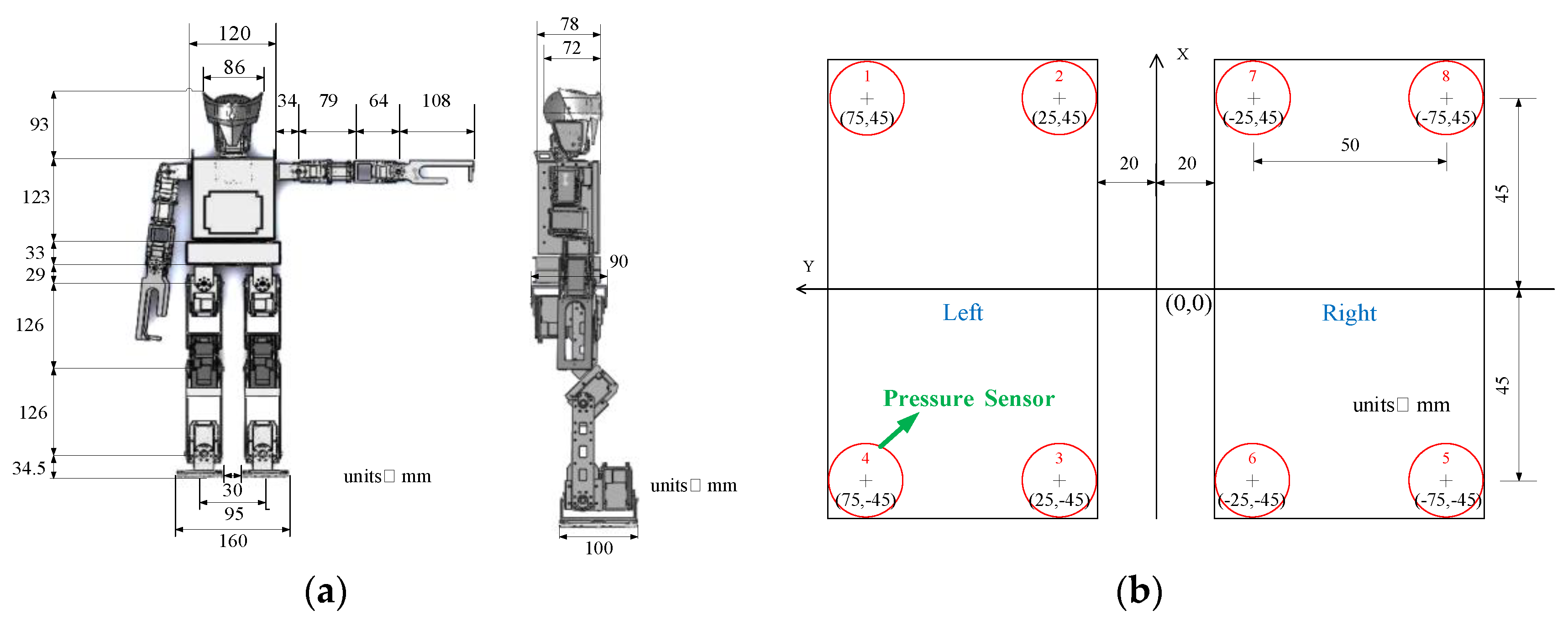
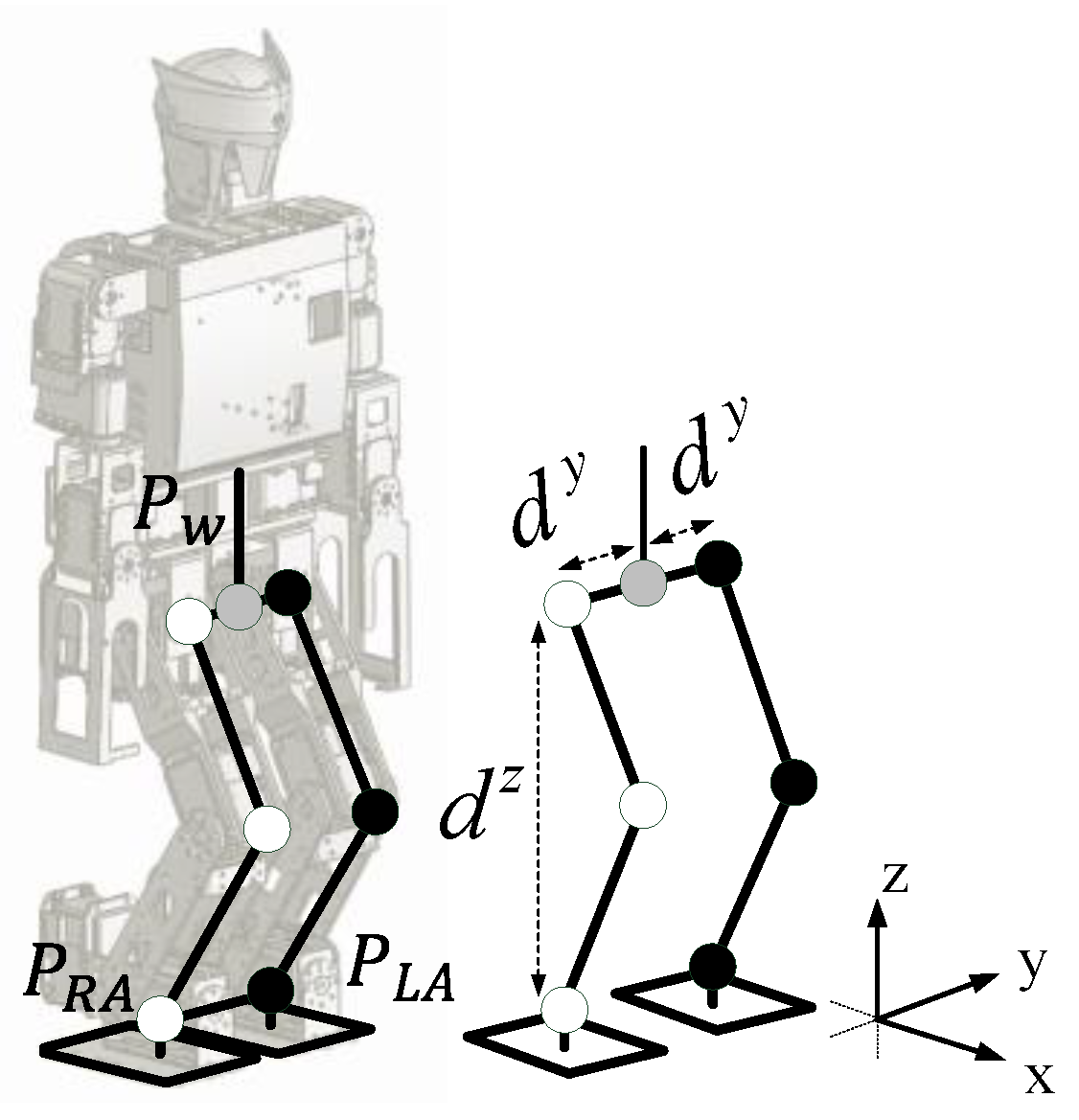
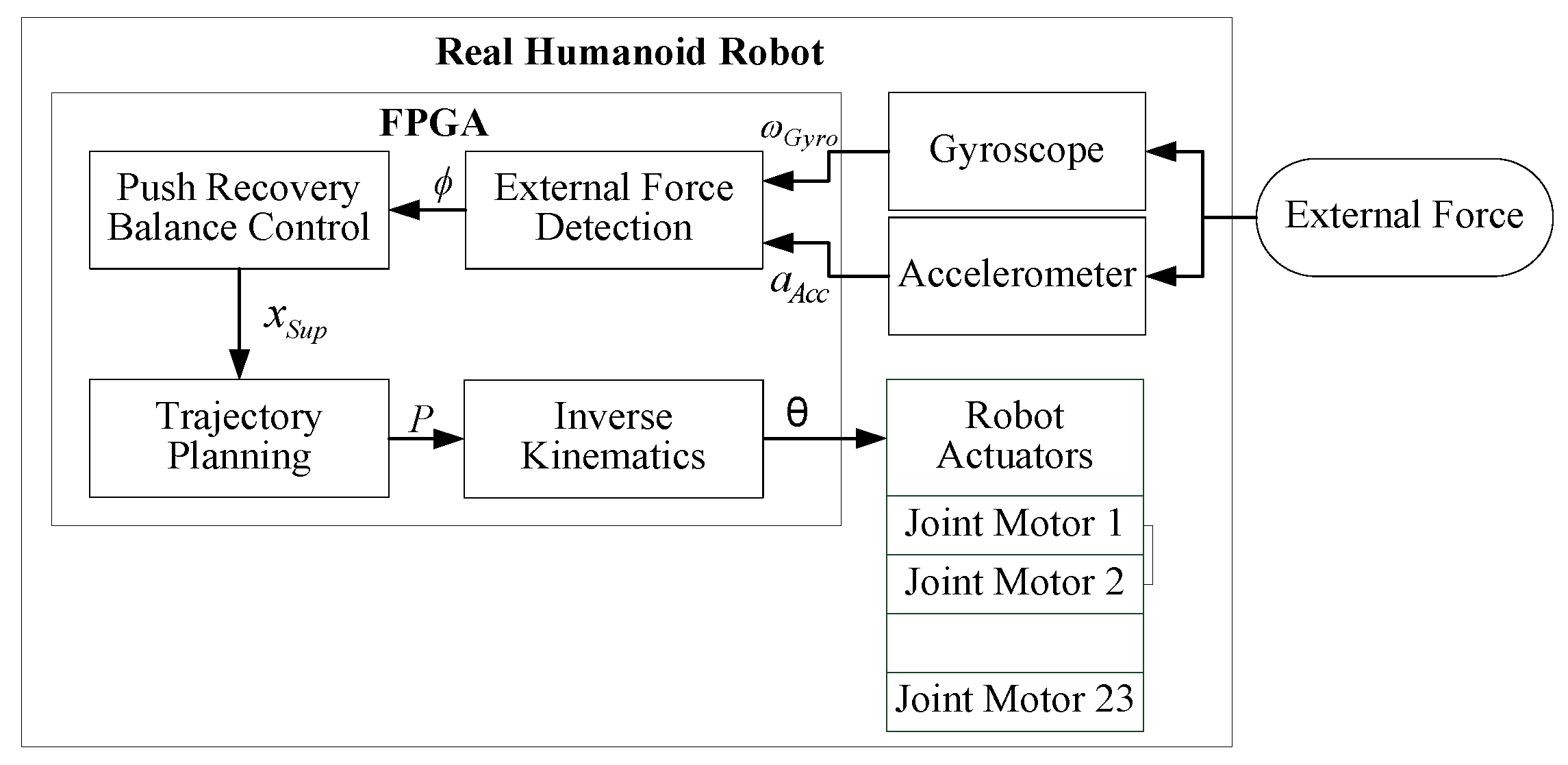

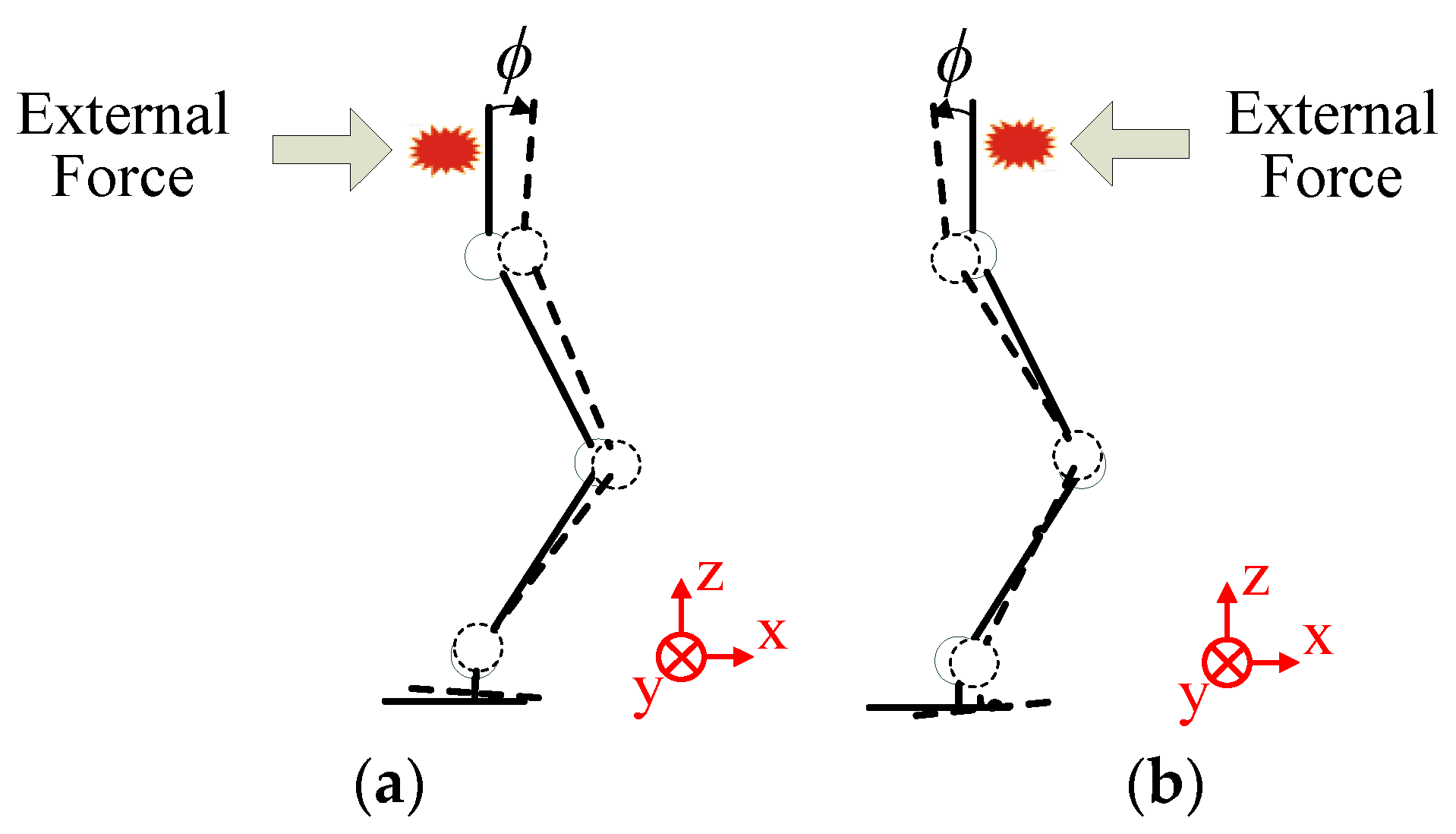


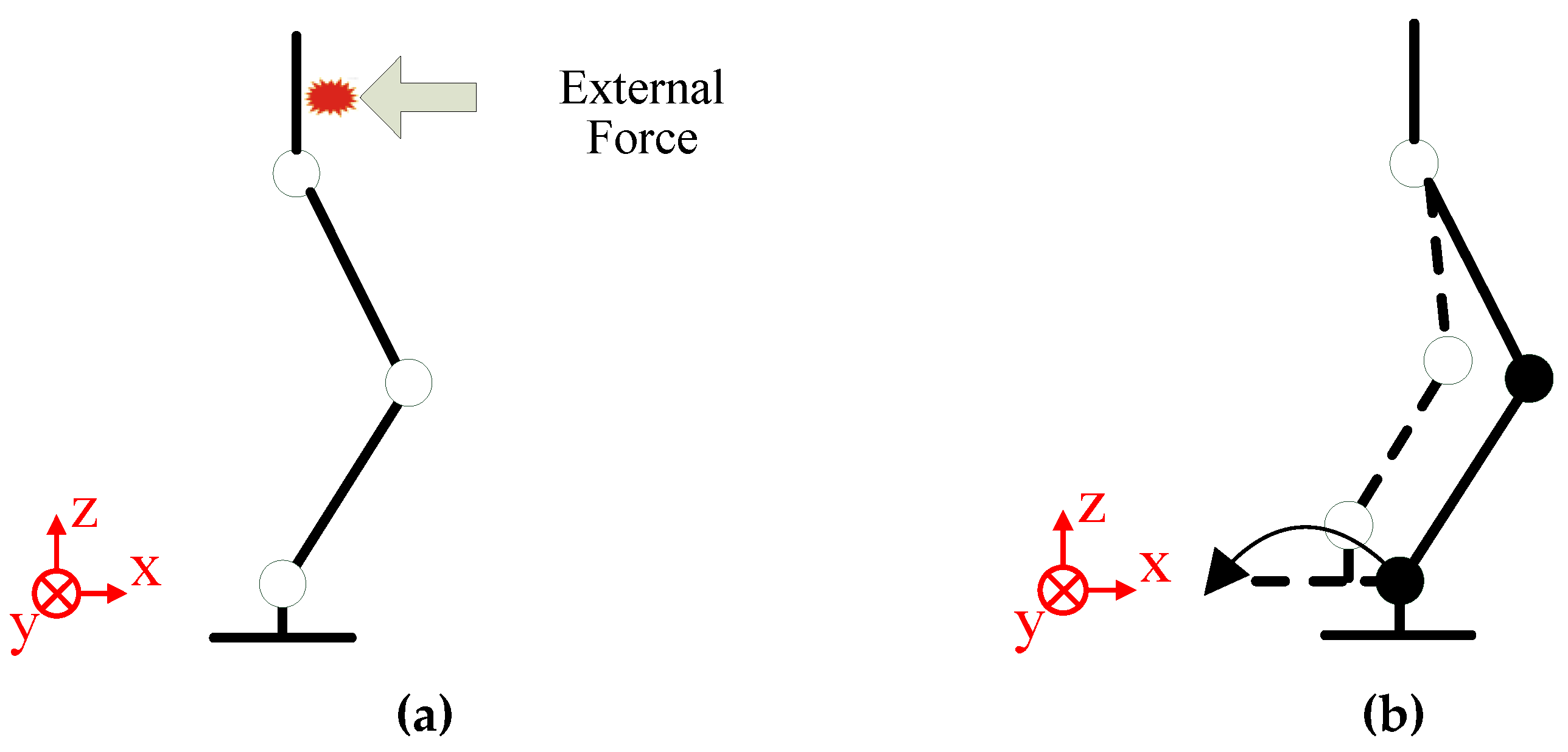
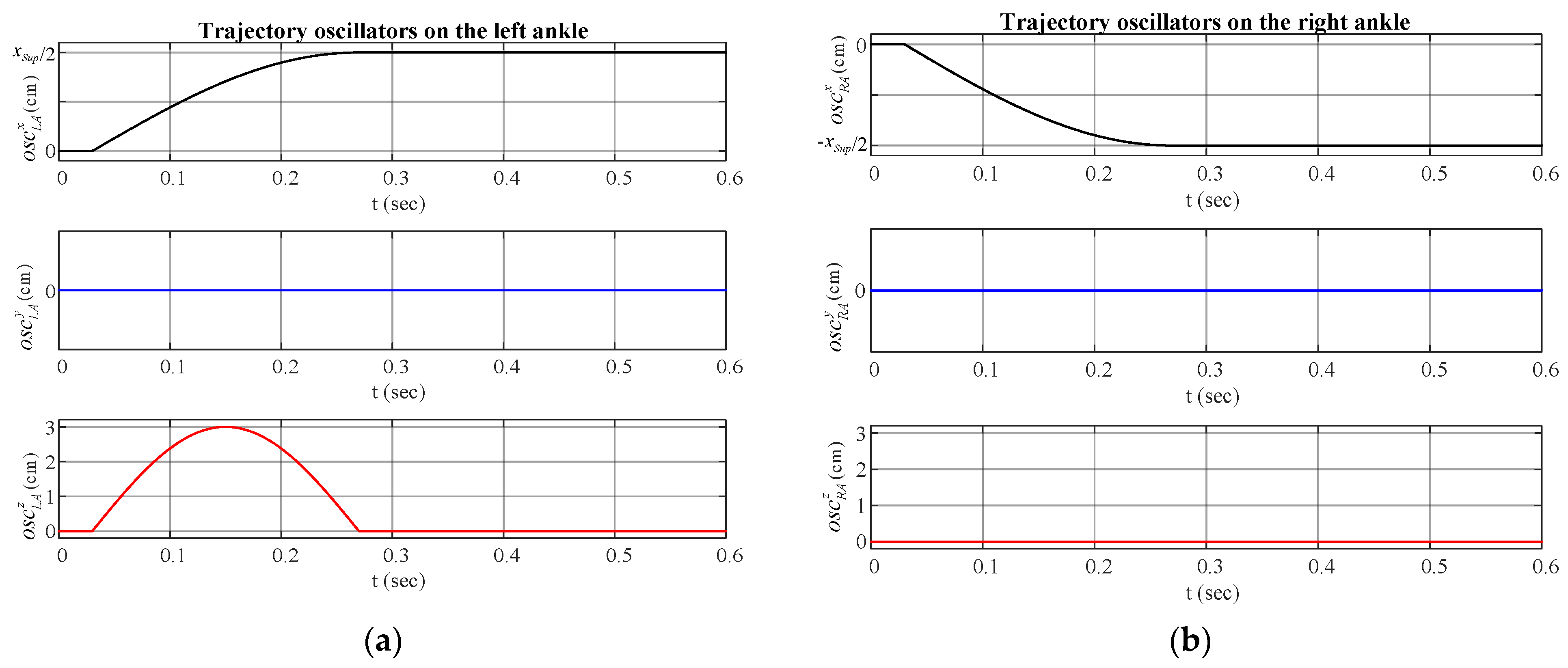






| Category | Description | Data |
|---|---|---|
| Dimension | Height | 564.5 mm |
| Weight | 4.5 kg | |
| DOFs | Head | 2 DOFs |
| Arm | 2 × 4 DOFs | |
| Waist | 1 DOF | |
| Leg | 2 × 6 DOFs | |
| Main Controller (FPGA board) | CPU | Altera Cyclone III EP3C120F780C8 |
| RAM | DDRII SDRAM 64 M × 2 | |
| Logic Gates | 119088 | |
| Power Requirement | 1 DC Power Jack with 5 V Power Input | |
| Size | 112 × 67 × 19 mm | |
| Actuator MX-28 (arm) | PID Controller | STM32F103C8 (CORTEX-M3) |
| Holding Torque | 2.5 N·m @ 12 V | |
| Speed | 55 PRM @ No Load | |
| Resolution | 0.088° | |
| Position Sensor | Magnetic Rotary Encoder AS5045 | |
| Actuator MX-64 (leg) | PID Controller | STM32F103C8 (CORTEX-M3) |
| Holding Torque | 6.0 N·m @ 12 V | |
| Speed | 63 PRM @ No Load | |
| Resolution | 0.088° | |
| Position Sensor | Magnetic Rotary Encoder AS5045 | |
| Sensors | Gyroscope | 3-Axis |
| Accelerometer | 3-Axis | |
| Pressure-meter | 4 per foot |
| Oscillator Parameters | Value |
|---|---|
| (, 0, 0) | |
| (, , ) | |
| (0, 0, 0) | |
| (, 0, ) | |
| (, , ) | |
| (0, 0, 0) |
| Type | Baseball | Volleyball |
|---|---|---|
| Picture |  |  |
| Weight | 160 g | 320 g |
| Volume | 179 cm3 | 2799 cm3 |
| Falling time | 0.34 s | |
| Force | 0.47 N | 0.93 N |
| External Force | Enable/Disable | Recovery Time | Step Length |
|---|---|---|---|
| 0.47 N | Disable | 0.60 s | X |
| 0.47 N | Enable | 0.25 s | 1.36 cm |
| 0.93 N | Disable | Falling Down | X |
| 0.93 N | Enable | 0.25 s | 4.15 cm |
| External Force | Enable/Disable | Recovery Time | Step Length |
|---|---|---|---|
| 0.47 N | Disable | 0.65 s | X |
| 0.47 N | Enable | 0.20 s | 1.09 cm |
| 0.93 N | Disable | 0.97 s | X |
| 0.93 N | Enable | 0.37 s | 3.88 cm |
© 2020 by the authors. Licensee MDPI, Basel, Switzerland. This article is an open access article distributed under the terms and conditions of the Creative Commons Attribution (CC BY) license (http://creativecommons.org/licenses/by/4.0/).
Share and Cite
Liu, C.-C.; Lee, T.-T.; Xiao, S.-R.; Lin, Y.-C.; Lin, Y.-Y.; Wong, C.-C. Real-Time FPGA-Based Balance Control Method for a Humanoid Robot Pushed by External Forces. Appl. Sci. 2020, 10, 2699. https://doi.org/10.3390/app10082699
Liu C-C, Lee T-T, Xiao S-R, Lin Y-C, Lin Y-Y, Wong C-C. Real-Time FPGA-Based Balance Control Method for a Humanoid Robot Pushed by External Forces. Applied Sciences. 2020; 10(8):2699. https://doi.org/10.3390/app10082699
Chicago/Turabian StyleLiu, Chih-Cheng, Tsu-Tian Lee, Sheng-Ru Xiao, Yi-Chung Lin, Yi-Yang Lin, and Ching-Chang Wong. 2020. "Real-Time FPGA-Based Balance Control Method for a Humanoid Robot Pushed by External Forces" Applied Sciences 10, no. 8: 2699. https://doi.org/10.3390/app10082699
APA StyleLiu, C.-C., Lee, T.-T., Xiao, S.-R., Lin, Y.-C., Lin, Y.-Y., & Wong, C.-C. (2020). Real-Time FPGA-Based Balance Control Method for a Humanoid Robot Pushed by External Forces. Applied Sciences, 10(8), 2699. https://doi.org/10.3390/app10082699




